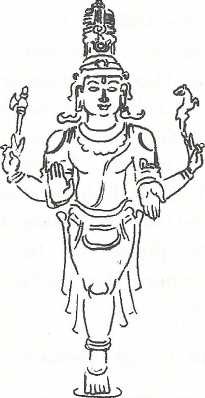Talk:Ekapadamurti
Ekapādamurti (‘image with one leg’) God has sometimes been described in the Hindu scriptures as Ekapāt or Ekapādah since the manifested universe is only a quarter (pāda = quarter) of him. The word is applied to both Siva and Viṣṇu. ‘Ajaikapāt’ is one of the epithets of Siva, used even in the Rgveda (6.50.14; 10.64.4).
The Ekapadamurti is actually the iconographic representation of the Vedic
concept of Siva as Ajaikapāt. In this form he has only one leg. He is described as the nakṣatras should be different. If they are the same, then they should be of the auspicious type. For instance, the nakṣatras Rohiṇī, Ārdrā, Makha, Viśākha, Puṣya, Srāvaṇa, Revati and Uttarābhādrā are considered highly auspicious. On the other hand, Pṅrvābhādra, Dhaniṣṭhā, Punarvasu, Kṛttikā, Mṛgaśira, Citta, Hasta, Uttara-phalgunī, Jyeṣṭhā, Purvā- ṣāḍhā and Uttarāṣāḍhā are considered prohibited and hence, inauspicious. Even when marriage is performed between persons having a permitted ekanakṣatra, the pādas (quarters) should be different.
Violation of these rules may result in evil consequences including the death of one of the spouses.
See also VIVĀHA.
Ekānainśā (‘One who is without parts’)
Ekānaihśā is a folk goddess who is identified with Durgā, who was the daugh¬ter of Nanda and Yaśodā. It was she who was exchanged for baby Kṛṣṇa. She escaped from the clutches of the tyrant Kariisa, warned him of his approaching death and disappeared.
She is also described as the tribal divinity of the Vṛṣṇi clan, of Kṛṣṇa-Vāsu- deva. She again, is pictured as Subhadrā, the sister of Balarāma and Kṛṣṇa.
Iconographical representations show her in the standing posture, with two arms, one resting on the loins and the other holding a lotus.

